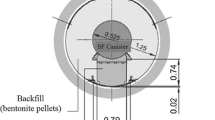Abstract
The radioactive decay heat from nuclear waste packages may, depending on the thermal load, create coupled thermal-mechanical-hydrological-chemical (TMHC) processes in the near-field environment of a repository. A group of tests on a large block (LBT) are planned to provide a timely opportunity to test and calibrate some of the TMHC model concepts. The LBT is advantageous for testing and verifying model concepts because the boundary conditions are controlled, and the block can be characterized before and after the experiment. A block of Topopah Spring tuff of about 3 × 3 × 4.5 m was sawed and isolated at Fran Ridge, Nevada Test Site. Small blocks of the rock adjacent to the large block were collected for laboratory testing of some individual thermal-mechanical, hydrological, and chemical processes. A constant load of about 4 MPa will be applied to the top and sides of the large block. The sides will be sealed with moisture and thermal barriers. The large block will be heated by heaters within and guard heaters on the sides so that a dry-out zone and a condensate zone will exist simultaneously. Temperature, moisture content, pore pressure, chemical composition, stress, and displacement will be measured throughout the block during the heating and cool-down phases. The results from the experiments on small blocks and the tests on the large block will provide a better understanding of some concepts of the coupled TMHC processes. The progress of the project is presented in this paper.
Similar content being viewed by others
References
Montazer P. M., and W. E. Wilson (1984), “Conceptual hydrologic model of flow in the unsaturated zone, Yucca Mountain, Nevada,” USGS-84-4345 Water Resources Investigative Report, U.S. Geol. Survey, Denver. CO. (NNA.890327.0051)
Ramirez A. L. (1991). Prototype Engineered Barrier System Field Test (PEBSFT) Final Report, Lawrence Livermore National Laboratory, UCRL-ID-106159. (NNA. 910711.0047)
Buscheck T. A., D. G. Wilder, and J. J. Nitao (1993), “Large-Scale In Situ Heater Tests for Hydrothermal Characterization at Yucca Mountain”, in High Level Radioactive Waste Management, Proceedings of the Fourth Annual International Conference, Las Vegas, Nevada, April 26 - 30, 1993, American Nuclear Society, La Grange Park, IL, also Lawrence Livermore National Laboratory, UCRL-JC-112445. (NNA.930217.0046)
Daily W. D., W. Lin, and T. Buscheck (1987), “Hydrological Properties of Topopah Spring Tuff: Laboratory Measurements,” J. Geophys. Res., Vol. 92, No. B8. pp. 7854–7864. (NNA.900123.0064)
Daily W. D., and A. L. Ramirez (1989), “Evaluation of Electromagnetic Tomography to Map In Situ Water in Heated Welded Tuff,” Water Resources Research, Vol. 25, No. 6, pp. 1083–1096. (NNA.910326.0097)
Lin W., A. L. Ramirez, and D. Watwood (1991, “Temperature Measurements,” Chapter 7 of Prototype Engineered Barrier System Field Test (PEBSFT) Final Report, A. L. Ramirez, Sci. Ed., Lawrence Livermore National Laboratory Livermore, CA, UCRL-ID-106159, pp. 82–93. (NNA.910711.0047)
Lin W., and W. Daily (1989), “Laboratory Study of Fracture Healing in Topopah Spring Tuff -Implications for Near Field Hydrology,” Proceedings of the Topical Meeting on Nuclear Waste Isolation in the Unsaturated Zone, Focus’ 89, American Nuclear Society, La Grange Park, IL. (NNA.900711.0241)
Lin W., and W. Daily (1990), “Hydrological Properties of Topopah Spring Tuff under a Thermal Gradient - Laboratory Results,” Int. J. Rock Mech. Min. Sci. & Geomech. Abstr. Vol. 27, No. 5, pp. 373–385. (Readily Available)
Lin W. (1991), “Variation of Permeability with Temperature in Fractured Topopah Spring Tuff Samples,” in High Level Radioactive Waste Management, Proceedings of the Second Annual International Conference, Las Vegas, Nevada, April 28 - May 3, 1991, American Nuclear Society, La Grange Park, IL, pp. 988–993. (NNA.910523.0105)
Lin W. (1993), Technical Basis and Programmatic Requirements for Large Block Testing of Coupled Thermal-Mechanical-Hydrological-Chemical Processes, Lawrence Livermore National Laboratory, Livermore, CA, UCRL-ID-112834. (NNA.930903.0075)
Kim K. and W. M. McCage (1984), “Geomechanics Characterization of the Candidate Nuclear Waste Repository Site in Basalt”, Proceedings in the 25th U.S. Symposium on Rock Mechanics, pp. 874–882. (NNA.891212.0018)
Zimmerman R. M., and M. K. Blanford (1986), “Expected Thermal and Hydrothermal Environments for Waste Emplacement Holes Based on G-Tunnel Heater Experiments,” in 27th U.S. Symposium on Rock Mechanics, H. Hartman, Ed., (Society of Mining Engineers, Inc., Littleton, CO), pp. 874–882. (NNA.891212.0018)
Wilder D. G. (1993), “Alternative Strategies - A Means for Saving Money and Time on the Yucca Mountain Project,” in High Level Radioactive Waste Management, Proceedings of the Fourth Annual International Conference, Las Vegas, Nevada, April 26-30, 1993, American Nuclear Society, La Grange Park, IL, pp. 1263–1270, also Lawrence Livermore National Laboratory, UCRL-JC-111652. (NNA.930224.0019)
Foltz S. D., V. C. Tidwell, R. J. Glass, C. A. Kelsey, and R. R. Eaton (1992), “An Experimental Investigation of Matrix Interaction on Fracture Flow,” EOS Transactions, 1992, Fall Meeting, American Geophysical Union, San Francisco, CA, December 7-1, p.223. (Abstract-readily available)
Tidwell V. C., and R. J. Glass (1992), “X-ray and Visible Light Transmission as Two-dimensional, Full-field Moisture-sensing Techniques: A Preliminary Comparison,” High Level Radioactive Waste Management, Proceedings of the Third International Conference, April 12-16, 1992, American Nuclear Society, La Grange Park, IL, and American Society of Civil Engineers, New York, NY, pp. 1099–1110. (NNA.930205.0015)
Danko G., and P. F. Mousset-Jones, (1991), “A Probe Method for Measuring In Situ Thermophysical Properties,” in Proceedings, 2nd International High Level Radioactive Waste Management Conference, Las Vegas, NV, April 28-May 3, 1991, American Nuclear Society, La Grange Park, IL, pp. 555–563. (Readily Available)
Author information
Authors and Affiliations
Rights and permissions
About this article
Cite this article
Lin, W., Wilder, D.G., Blink, J.A. et al. A Large Block Heater Test for High Level Nuclear Waste Management. MRS Online Proceedings Library 353, 411–418 (1994). https://doi.org/10.1557/PROC-353-411
Published:
Issue Date:
DOI: https://doi.org/10.1557/PROC-353-411




